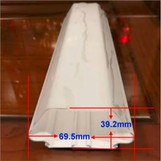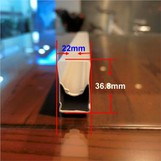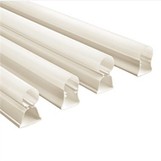Hey there! As a supplier of Triproof Light Covers, I've been getting a lot of questions lately about how these covers affect the color rendering of the light. So, I thought I'd sit down and write a blog post to share what I've learned.
First off, let's talk about what color rendering is. Color rendering is all about how accurately a light source shows the true colors of objects compared to natural light. We measure it using something called the Color Rendering Index (CRI). A CRI of 100 means the light source shows colors just as accurately as natural sunlight. The lower the CRI, the more the colors might look off.
Now, how does a Triproof Light Cover come into play here? Well, Triproof Light Covers are designed to be tough. They're waterproof, dustproof, and can handle a lot of abuse. They're made from different materials, like polycarbonate (PC), and each material can have an impact on the light's color rendering.
One of the main ways a Triproof Light Cover affects color rendering is through light transmission. When light passes through the cover, some of it gets absorbed or scattered. This can change the color spectrum of the light that comes out. For example, if the cover absorbs more of the blue light, the light that reaches your eyes might look a bit warmer, with a more yellow or orange tint.
Let's take a closer look at the materials. Polycarbonate is a popular choice for Triproof Light Covers because it's strong and has good light transmission properties. But even PC covers can vary in how they affect color rendering. Some high - quality PC covers are designed to have minimal impact on the light's color. They're engineered to let as much of the original light spectrum pass through as possible, so the CRI of the light remains close to that of the bare light source.
On the other hand, lower - quality covers might have impurities or a less - uniform structure. These can cause more light scattering and absorption, which can lead to a significant drop in the CRI. When the CRI drops, the colors of the objects illuminated by the light might look duller or have an unnatural hue.
Another factor is the thickness of the cover. A thicker cover will generally absorb and scatter more light than a thinner one. So, if you're using a very thick Triproof Light Cover, it's more likely to have a negative impact on color rendering. However, sometimes a thicker cover is necessary for added protection in harsh environments. In those cases, you might need to look for a cover that's specifically designed to maintain good color rendering despite its thickness.
Now, let's talk about the different types of Triproof Light Covers we offer. We have the IP65 Tri Proof Light Cover. This cover is rated IP65, which means it's completely protected against dust and can withstand low - pressure water jets. It's made from high - quality materials that are carefully selected to minimize the impact on color rendering. So, you can have both the protection you need and good color accuracy.
Our Tri Proof Light LED Cover is another great option. It's specifically designed for LED lights and is optimized to work well with the unique light characteristics of LEDs. LEDs already have good color rendering in many cases, and this cover helps to preserve that.


If you have specific requirements, we also offer the Custom Waterproof Tri-proof Diffuser PC LED Light Cover. With this option, you can get a cover that's tailored to your exact needs. Whether you need a certain thickness, a specific level of light diffusion, or want to ensure excellent color rendering, we can work with you to create the perfect cover.
So, how do you choose the right Triproof Light Cover to maintain good color rendering? First, look at the CRI rating of the light source itself. If it has a high CRI, you'll want a cover that won't bring that rating down too much. Second, consider the environment where the light will be used. If it's a place where accurate color perception is crucial, like an art gallery or a retail store, you'll need a cover with minimal impact on color.
In addition, you can ask for samples of different covers and test them with your light source. This way, you can see firsthand how each cover affects the color of the light and the objects it illuminates. You can set up a simple test area and compare the colors under different covers.
As a supplier, we're always here to help. We have a team of experts who can answer your questions and guide you through the selection process. Whether you're a lighting designer, an installer, or a business owner looking for the right Triproof Light Covers, we've got you covered.
If you're interested in purchasing Triproof Light Covers or want to learn more about how they can affect color rendering, don't hesitate to get in touch. We can provide you with detailed product information, samples, and pricing. Let's work together to find the perfect solution for your lighting needs.
References
- "Lighting Handbook: Reference and Application", Illuminating Engineering Society of North America
- "Color Science: Concepts and Methods, Quantitative Data and Formulae", Gunter Wyszecki and W. S. Stiles




